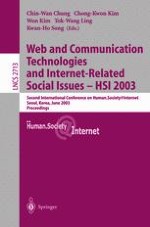2003 | OriginalPaper | Buchkapitel
Analysis of User Utility Function in the Combined Cellular/WLAN Environments
verfasst von : Jae-Hwan Kim, Young Yong Kim
Erschienen in: Web and Communication Technologies and Internet-Related Social Issues — HSI 2003
Verlag: Springer Berlin Heidelberg
Enthalten in: Professional Book Archive
Aktivieren Sie unsere intelligente Suche, um passende Fachinhalte oder Patente zu finden.
Wählen Sie Textabschnitte aus um mit Künstlicher Intelligenz passenden Patente zu finden. powered by
Markieren Sie Textabschnitte, um KI-gestützt weitere passende Inhalte zu finden. powered by
Recent advances in wireless networking technologies enabled nomadic users connected to the Internet anywhere from the outdoor environments such as airport, hotel, subway station, or university campus as well as conventional indoor uses. As wireless technologies evolve, multiple wireless access technologies have been adopted. Cellular service and wireless LAN are two most popular access methods currently. In this paper, we open up new aspect of user utility function [1] in the circumstances that nomadic users have access to multiple wireless access methods. In cellular networks with wireless LAN hotspots overlaid, users have to frequently switch among multiple access technologies. Our goal is to find optimal strategy for choosing among multiple access technologies in view of maximum user utility, i.e. the degree of user satisfaction. By taking user utility function into account, one can figure out whether the change of wireless link benefits for the user satisfaction or not. In addition, ISPs can also utilize the concepts for the design of overlaid wireless network architectures to guarantee some appropriate level of user satisfaction. Mathematical derivation of user utility and numerical examples are provided for our proposal.
